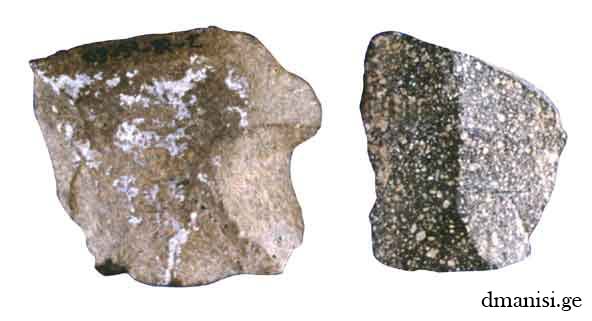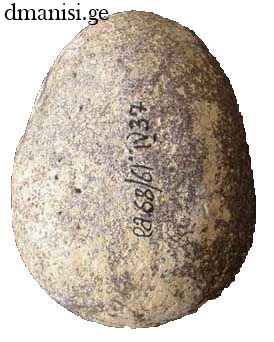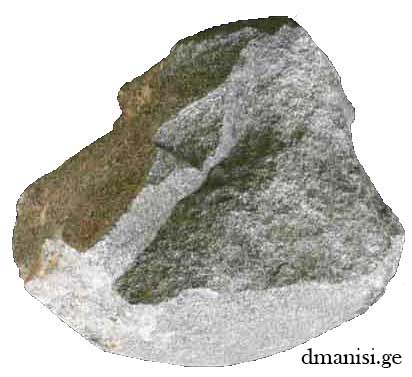Paleolithic Dmanisi
STONE ARTIFACTS
In the history of human evolution 2.5-2 million years BP is an important stage –first hominids started to make and use stone-tools.
 In Dmanisi over 8000 stone artifacts have been recovered until now, they are present in all geologic layers. Lithic artifacts are particularly common in stratum B.
In Dmanisi over 8000 stone artifacts have been recovered until now, they are present in all geologic layers. Lithic artifacts are particularly common in stratum B.
Stone-tools are manufactured from almost 40 different raw materials. Petrographic analyses of the recovered stone tools show that hominins here exploited the pebbles and cobbles available in the valleys of the Mashavera and Phinezauri rivers as well as angular pieces from cretaceous rocks.
 Dmanisi lithic assemblage is composed of numerous flakes (sharp, thin piece of stone), debris (broken stone pieces), cores (core of the stone from which the tools [flakes] were produced), coretools (fist-sized piece of rock: the largest and most primitive tool) and hammerstones (used for knocking off the large flakes form the core). It is important to remark the existence of the nonmodified material (manuports). The study of these materials (measurements and morphology) showed that they were selected and brought to the site by the living hominids.
Dmanisi lithic assemblage is composed of numerous flakes (sharp, thin piece of stone), debris (broken stone pieces), cores (core of the stone from which the tools [flakes] were produced), coretools (fist-sized piece of rock: the largest and most primitive tool) and hammerstones (used for knocking off the large flakes form the core). It is important to remark the existence of the nonmodified material (manuports). The study of these materials (measurements and morphology) showed that they were selected and brought to the site by the living hominids.
For the Dmanisi hominins, the main goal was to create artifacts with a sharp edge for cutting; these flakes were made by striking the core with a hammerstone, for this, they were hitting one stone on another with the angle of striking platform over 90 degrees (hard hammer technique).
 The study of the cores yields important information regarding the exploitation of lithic resources by hominids. Flaking on the surfaces of cores and the resulting interaction among them result in unifacial, bifacial and multifacial systems. The directionality of flaking allows the distinction of unipolar, bipolar, centripetal and ortogonal strategies.
The study of the cores yields important information regarding the exploitation of lithic resources by hominids. Flaking on the surfaces of cores and the resulting interaction among them result in unifacial, bifacial and multifacial systems. The directionality of flaking allows the distinction of unipolar, bipolar, centripetal and ortogonal strategies.
The flakes are mostly small, – about 36 mm long, with sharp edges. Among them, at least 200 show the signs of utilization that are localized on one side.
Retouched flakes are rare, but slightly retouched pieces are present.
The stone artifacts from Dmanisi share similarities with artifacts found in Oldowan sites in Africa and Eurasia – all having simple core-flake technologies , but keeping their own peculiarity in terms of abundance of raw materials, making Dmanisi quite different from the rest of the sites.
